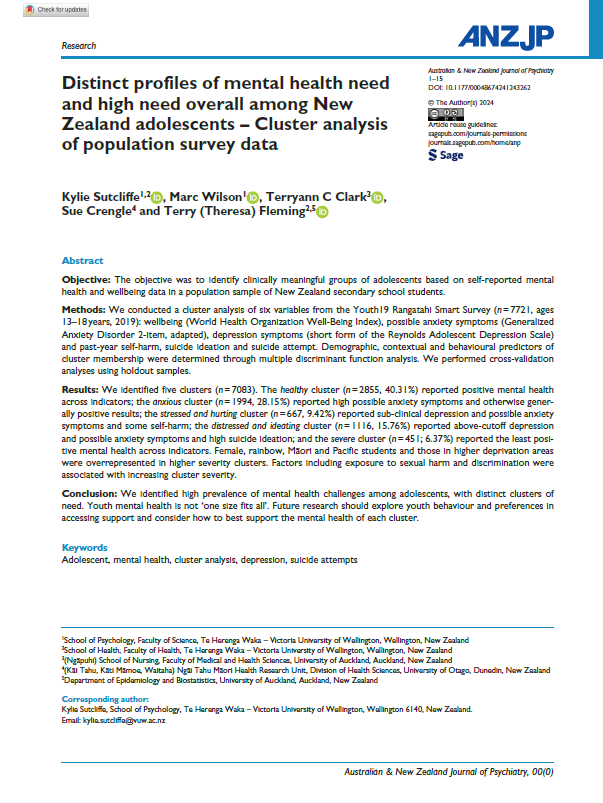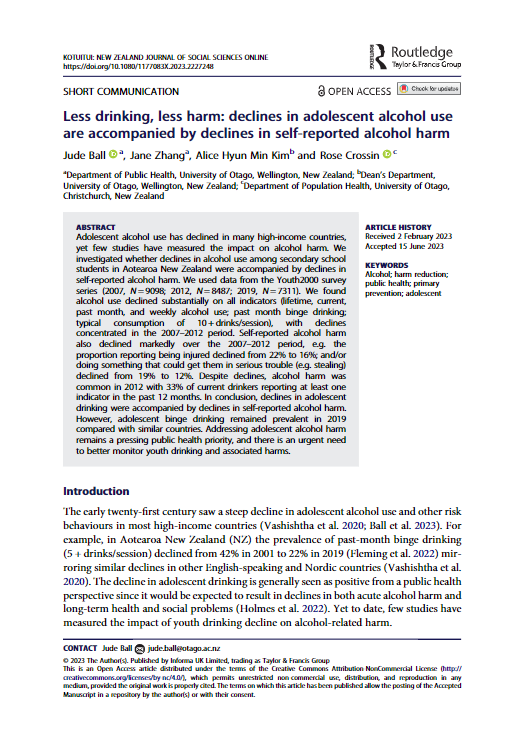This document provides an overview from multiple Youth2000 outputs re youth mental health needs and opportunities for youth mental health gains in Aotearoa.
Register for the in-person launch of this report on 11 October 2024 here.
We statistically allocated Youth19 participants to clusters based on self-reported wellbeing, depression symptoms, possible anxiety symptoms, and past-year self-harm, suicide ideation, and suicide attempt. Key findings:
We identified five distinct clusters
Only 40% of participants were classed as healthy with no significant symptoms on any included measures
Around 6% appeared severe, with 100% prevalence of suicide attempt and high overall levels of self-harm, depression symptoms, and possible anxiety symptoms
Three intermediate clusters were characterised by high anxiety symptoms with otherwise positive results (anxious, 28%); scores approaching cutoffs for depression and anxiety symptoms and some self-harm (stressed and hurting, 9%); and above-cutoff scores for depression and possible anxiety symptoms and high suicide ideation without attempt (distressed and ideating, 16%)
Female, Māori, Pacific, and rainbow students were overrepresented in higher severity clusters, with inequities at least partially explained by exposure to harms such as sexual abuse and discrimination.
Talavou o le Moana summarises key findings for Pacific secondary school students in the areas of ethnic and gender identity; family and faith; socioeconomic environments and housing; education; friends and community connections; physical, mental and sexual health; substance use; and healthcare access. This data report gives a vital snapshot into the lives of Pacific young people. This information was collected as part of the Youth19 Rangatahi Smart Survey, the latest in the Youth2000 survey series conducted by the Adolescent Health Research Group (AHRG). The findings highlight the resilience and strength of Pacific talavou (young people), and the complexities they must navigate.
You can watch the launch of this report here.
Guntupalli, A. M., Lucassen, M. F. G., Fenaughty, J., Fleming, T., Peiris-John, R., Farrant, B., & Clark, T. C.
Highlights from this article:
Sexuality and gender minority youth (SGMY) are poorly served by healthcare services.
SGMY are more likely to have a long-term health condition.
Gender minority youth have especially high needs and difficulties accessing help.
This factsheet presents Pasifika-specific findings about alcohol use among secondary school students based on Youth 2000 survey data. It includes trends, data on self-reported experiences of alcohol harm, and risk and protective factors associated with high-risk drinking among Pasifika young people. It was developed in partnership with Alcohol Healthwatch, with guidance from Pasifika advisors. Further detail, including methods and data tables, is available in the associated Technical Report.
The findings are also presented in a webinar, which can be viewed here.
Suggested citation: Ball, J., Zhang, J., Kim, A., Poasa, L., Siataga, P., King-Finau, T., Su’a, A., Williams, R., Jackson, N. (2023) Understanding and addressing alcohol harm among Pasifika secondary school students. Factsheet. Wellington: University of Otago, Adolescent Health Research Group & Alcohol Healthwatch
KYLIE SUTCLIFFE, JUDE BALL, TERRYANN C CLARK, DAN ARCHER, ROSHINI PEIRIS-JOHN, SUE CRENGLE, TERRY (THERESA) FLEMING
This paper uses data from Youth19 and previous Youth2000 surveys to explore prevalence and trends of key mental health and well-being indicators. We found high mental health needs in 2019 and sharp increases between 2012 and 2019, particularly among female, Māori, Pacific and Asian students and those living in socioeconomically deprived neighbourhoods. Ethnic and socioeconomic disparities have widened.
This factsheet presents Rainbow-specific findings about alcohol use among secondary school students based on Youth 2000 survey data. It includes trends, data on self-reported experiences of alcohol harm, and risk and protective factors associated with high-risk drinking among Rainbow young people. It was developed in partnership with Alcohol Healthwatch, with guidance from Rainbow advisors. Further detail about methods is available in the associated Technical Report.
The findings are also presented in a webinar, which can be viewed here.
Suggested citation: Ball, J., Zhang, J., Anderson, C., Kim, A., Fenaughty, J., Ansell, B., Jackson, N. (2022) Understanding and addressing alcohol harm among Rainbow youth at secondary school. Factsheet. Auckland: Alcohol Healthwatch, University of Otago & Adolescent Health Research Group
This factsheet presents Māori-specific findings about alcohol use among secondary school students based on Youth 2000 survey data. It includes trends, data on self-reported experiences of alcohol harm, and risk and protective factors associated with high-risk drinking among Māori. It was developed in partnership with Alcohol Healthwatch, with guidance from Māori advisors. Further detail about methods is available in the associated Technical Report.
The findings are also presented in a webinar, which can be viewed here.
Suggested citation: Ball, J., Zhang, J., Roberts, A., Jackson, N., Kim, A., Sydney, M., Sullivan, G. Crengle, S. (2022) Understanding and addressing alcohol harm among rangatahi Māori at secondary school. Factsheet. Auckland: Alcohol Healthwatch, University of Otago & Adolescent Health Research Group
This paper uses data from Youth19 and previous Youth2000 surveys to explore experiences of racism among Māori and minority youth in Aotearoa New Zealand. The study found that structural factors enabling wealth, but more substantially, perceived ethnicity, give differential protection against racism.
More information including links to media coverage will be available on our news page and @Youth19NZ Twitter account.
This factsheet presents findings about where young people usually get alcohol from, and the relationship between alcohol source and risky drinking. It was developed in partnership with Alcohol Healthwatch. Further detail about methods is available in the associated Technical Report.
The findings are also presented in a webinar, which can be viewed here.
Suggested citation: Ball, J., Zhang, J., Kim, A., Crengle, S., Farrant, B., Birks-Ang, B., Jackson, N (2022) Sources of alcohol and harm among secondary school students. Factsheet. Auckland: Alcohol Healthwatch, University of Otago & Adolescent Health Research Group
This factsheet presents findings about self-reported consequences of alcohol use among adolescents such as being injured, having unsafe sex, or school work being affected. It was developed in partnership with Alcohol Healthwatch. Further detail about methods is available in the associated Technical Report.
The findings are also presented in a webinar, which can be viewed here.
Suggested citation: Ball, J., Zhang, J., Kim, A., Crengle, S., Farrant, B., Birks-Ang, B., Jackson, N. (2022) Alcohol harm among secondary school students. Factsheet. Auckland: Alcohol Healthwatch, University of Otago & Adolescent Health Research Group
This factsheet presents findings about factors in family/whānau, school and community settings that are associated with higher or lower likelihood of risky drinking. It was developed in partnership with Alcohol Healthwatch. Further detail about methods is available in the associated Technical Report.
The findings are also presented in a webinar, which can be viewed here.
Suggested citation: Ball, J., Zhang, J., Kim, A., Crengle, S., Farrant, B., Birks-Ang, B., Jackson, N. (2022) Risk and protective factors for alcohol use among secondary school students. Factsheet. Auckland: Alcohol Healthwatch, University of Otago & Adolescent Health Research Group.













